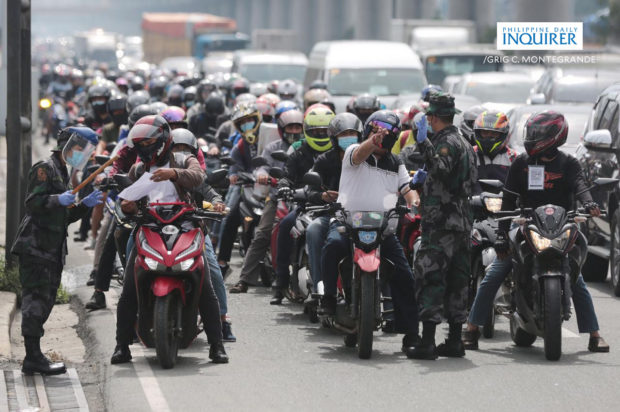
Police authorities set up checkpoint along Marcos Highway westbound at the border of Marikina City and Cainta, Rizal on Tuesday, August 4, 2020 as the national capital region (NCR) reverted back to a stricter modified enhanced community quarantine (MECQ) due to raising COVID-19 cases. — INQUIRER/GRIG C. MONTEGRANDE
MANILA, Philippines — Philippine National Police (PNP) chief Gen. Guillermo Eleazar on Monday asked the public to exercise patience while cooperating with authorities as heavy traffic and long queues are expected with the reimposition of the quarantine control points at various entry and exit points of the National Capital Region (NCR) Plus bubble.
As was in the past, the quarantine control points (QCPs) are expected to cause massive traffic build-up especially once Metro Manila goes under an enhanced community quarantine (ECQ) to avoid the spread of the COVID-19 Delta variant, said Eleazar.
Due to this, Eleazar asked people who can afford to stay indoors to remain inside their homes, to avoid adding to the congestion on the roads.
“Hinihingi din namin ang kooperasyon ng ating mga kababayan na manatili na lang sa bahay kung kinakailangan dahil hindi din naman sila papayagan pumasok sa Metro Manila at magiging bahagi lang sila ng suliranin sa trapiko at baka mahawa pa sila ng Delta dahil sa katigasan ng ulo, lalo na kung hindi naman sila bakunado,” Eleazar said in a statement.
The QCPs have been set up every time more stringent quarantine protocols are placed in an area, meant to limit travel to and from a particular locale, like the NCR Plus which features Metro Manila, Bulacan, Cavite, Rizal, and Laguna.
Last Friday, Malacañang announced that President Rodrigo Duterte has already approved the Inter-Agency Task Force for the Management of Emerging Infectious Diseases (IATF) resolution putting Metro Manila under an ECQ from August 6 to 20 amid the Delta variant’s threat.
Still, Eleazar said that there are ways to ease traffic congestion despite the ECQ declaration.
“Bilang dating commander ng Joint Task Force COVID shield, nakita ko based on experience ang matinding traffic sa mga border control points sa bawat pagpapatupad ng mahigpit na quarantine rules sa Metro Manila,” he said.
“Kaya naman nagkaroon kami noon ng mga istratehiya upang mabawasan ang traffic build-up na siya namang inaasahan kong ipatupad lalo na sa pagsisimula ng ECQ implementation sa August 6,” he added.
One of the strategies, Eleazar noted, was to allow all vehicles to pass the QCPs to avoid traffic and then doing random checks along mobile checkpoints set up in key Metro Manila areas.
He also urged motorists and other authorized people outside residences (APOR) to prepare the needed documents and identification cards to support their trips.
“Sa mga APORs, ihanda ninyo na rin ang inyong mga dokumento o IDs na kailangan para maging mabilis ang pagusad ng pila sa ating mga QCPs,” Eleazar said.
The ECQ status over Metro Manila would start by Friday, but the Department of the Interior and Local Government have already placed borders starting Sunday midnight to restrict movement and discourage non-essential travel amid the more strict quarantine protocols.
Since Friday, the Department of Health has reported over 8,000 new COVID-19 infections per day, with the active COVID-19 case count staying above 60,000.
It is not clear whether the stark increase in cases could be attributed to the more infectious COVID-19 Delta variant, but analytics group OCTA Research speculated that seven percent of the country’s active patients may already be carrying the Delta variant.
Earlier, OCTA Research also warned that a community transmission may already be happening in Metro Manila.
Experts say that the Delta variant, first detected in India, is said to be the most prominent and virulent variant in the world now, compared to the original strain from Wuhan, China.